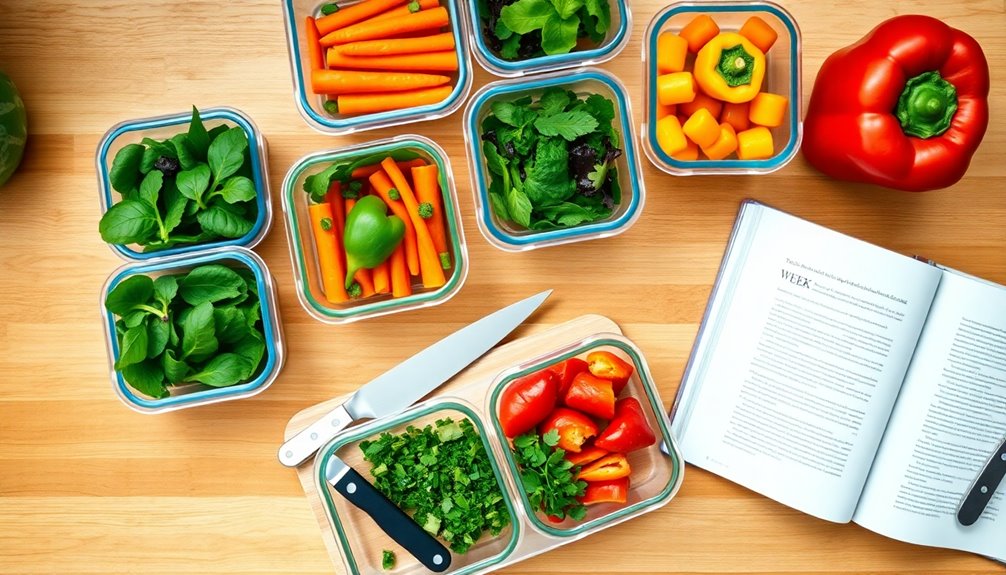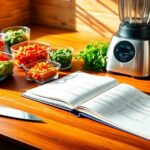To meal prep for a week of healthy eating, start by evaluating your schedule to find dedicated prep time. Choose well-rounded recipes with proteins, carbohydrates, and healthy fats. Create a shopping list focusing on whole foods and seasonal ingredients. Organize your kitchen for efficiency—label containers and keep frequently used items accessible. Cook in batches, portion meals into glass containers or mason jars, and label them with reheating instructions. Embrace flexibility with your ingredients to avoid monotony. By following these steps, you can ensure nourishing meals readily available, setting yourself up for success and a healthier week ahead. More tips await you.
Key Takeaways
- Assess your weekly schedule to find dedicated time for meal prep and cooking.
- Choose balanced recipes that meet your nutritional and dietary needs, emphasizing whole, seasonal ingredients.
- Create a detailed shopping list focused on nutrient-dense foods, and stock versatile pantry staples.
- Cook larger portions in batches, storing meals in labeled containers for easy access and reheating.
- Incorporate a variety of proteins, grains, and vegetables to enhance meal variety and maintain balanced nutrition.
Assess Your Weekly Schedule
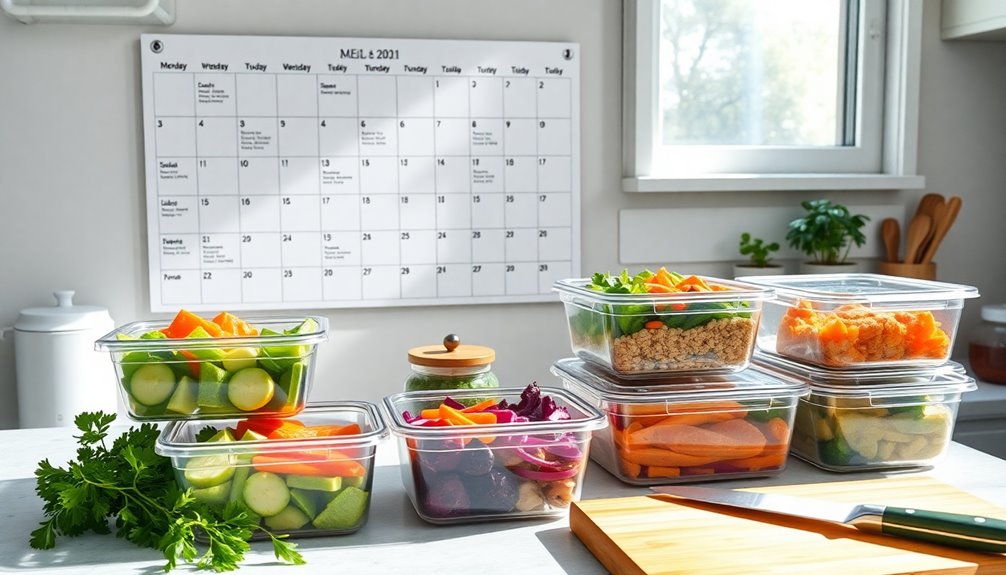
To kick off your meal prep journey, take a close look at your weekly agenda. This step is essential for effective time management. By evaluating your commitments, you'll identify when you have dedicated time for meal prepping. Start by noting any work obligations, family activities, or social events. Once you have a clear picture, you can prioritize activities that align with your health goals.
Consider blocking out specific time slots for meal prep. Maybe Sunday afternoons work best for you, or perhaps you can squeeze in some time during weekday evenings. Whatever your schedule allows, consistency is key. When you set a regular time for meal prep, it becomes a part of your routine, making healthy eating feel more manageable and less overwhelming.
Next, think about what meals or snacks you'll need for the week. Are there days when you'll be busier than others? If so, prioritize prepping meals for those days.
You might choose to make larger batches of versatile dishes that can be easily reheated or repurposed throughout the week.
Choose Balanced Recipes
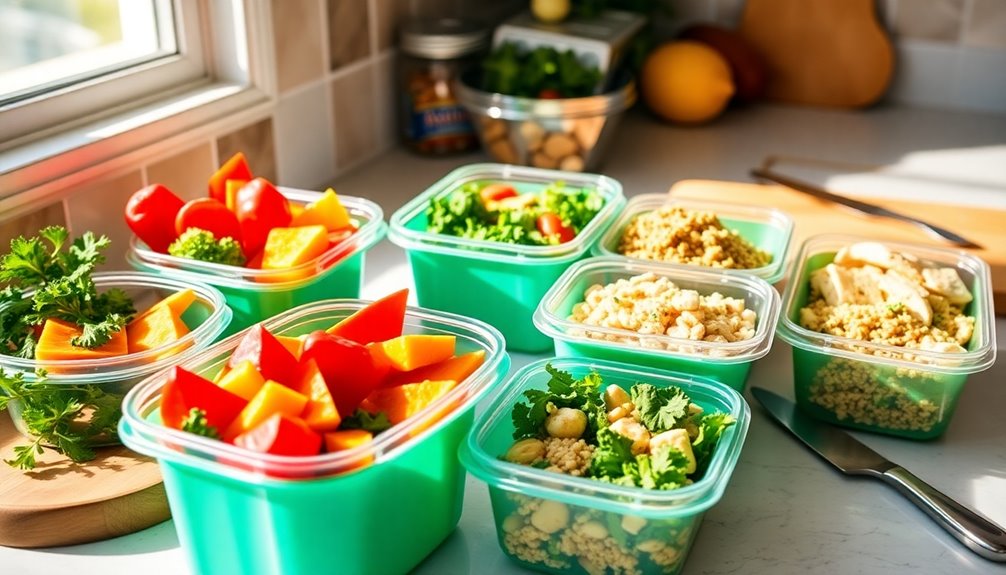
With your meal prep schedule in place, the next step is selecting recipes that offer balanced nutrition. Aim for a mix of protein, healthy fats, and carbohydrates to secure nutritional balance in your meals. Consider incorporating a variety of ingredients to keep things interesting and prevent boredom. Recipe variety is essential not just for taste but also for maximizing nutrient intake.
When choosing recipes, think about any dietary restrictions you or your family might have. Whether it's gluten-free, vegetarian, or low-carb, there are plenty of options that can cater to these needs without compromising flavor. Look for recipes that highlight vibrant flavor profiles to make each meal enjoyable. You'll find that experimenting with herbs, spices, and different cooking methods can elevate even simple dishes.
Don't hesitate to explore diverse cuisines, as they often offer unique flavor combinations and ingredients. For example, a Mediterranean bowl might combine quinoa, chickpeas, roasted vegetables, and a drizzle of tahini for a fulfilling meal that's packed with nutrients.
As you gather recipes, consider how they can complement each other throughout the week. This approach not only helps with grocery shopping later but also facilitates creative meal assembly. By selecting balanced recipes that cater to your preferences and requirements, you'll foster a sense of belonging with your food choices, making healthy eating a more enjoyable journey.
Create a Shopping List
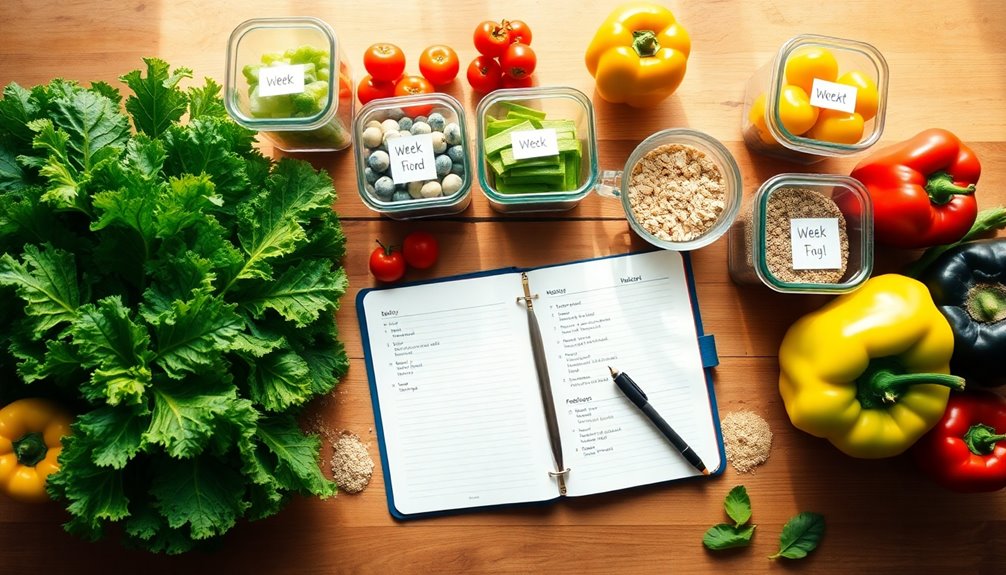
Creating a shopping list is an essential step in your meal prep journey, ensuring you have all the ingredients you need at hand. Effective meal planning begins with identifying the recipes you've chosen for the week. Write down each ingredient required for those recipes. This not only simplifies your shopping experience but also helps prevent impulse buys that can derail your healthy eating goals.
When it comes to ingredient selection, focus on whole, nutrient-dense foods that align with your balanced recipes. Aim for a colorful variety of fruits and vegetables, lean proteins, whole grains, and healthy fats. Group your items by category—produce, dairy, meat, and pantry staples—to streamline your trip through the grocery store. This organization can save you time and energy, making your shopping experience more enjoyable.
Don't forget to check your pantry and refrigerator before you head out. You might already have some items on hand, which could reduce your shopping list. Plus, by ensuring that your list reflects what you genuinely need, you'll minimize food waste and save money.
Lastly, consider planning your meals around seasonal ingredients. Not only are they typically fresher and more affordable, but they also create a sense of connection to your community and local farmers. By crafting a thoughtful shopping list, you set yourself up for success in your meal prep journey, making healthy eating a sustainable and enjoyable part of your life.
Organize Your Kitchen

A well-organized kitchen is crucial for successful meal prep and maintaining a healthy diet. When you establish an efficient kitchen layout, you'll discover it easier to adhere to your healthy eating objectives. Start by evaluating your space and ensuring that everything has a designated place. This reduces stress and saves time, making meal prep feel less overwhelming.
Here are a few practical tips to improve your kitchen organization:
- Utilize vertical space: Install shelves or pegboards to maximize storage options. This keeps essential items nearby while freeing up counter space.
- Group similar items: Store baking supplies, cooking utensils, and meal prep containers together. This not only streamlines your workflow but also helps you locate what you need quickly.
- Label your containers: Whether it's spices, grains, or snacks, clear labeling helps you identify exactly what you have on hand. It prevents food waste and simplifies meal planning.
- Keep frequently used items accessible: Place items you use daily, like cutting boards and knives, in convenient spots. This streamlines your cooking process and motivates you to prepare nutritious meals.
- Incorporating tools like mini bands can enhance your meal prep efforts by providing effective workouts that can be done anywhere, helping you stay active and support your healthy eating goals.
Cook in Batches
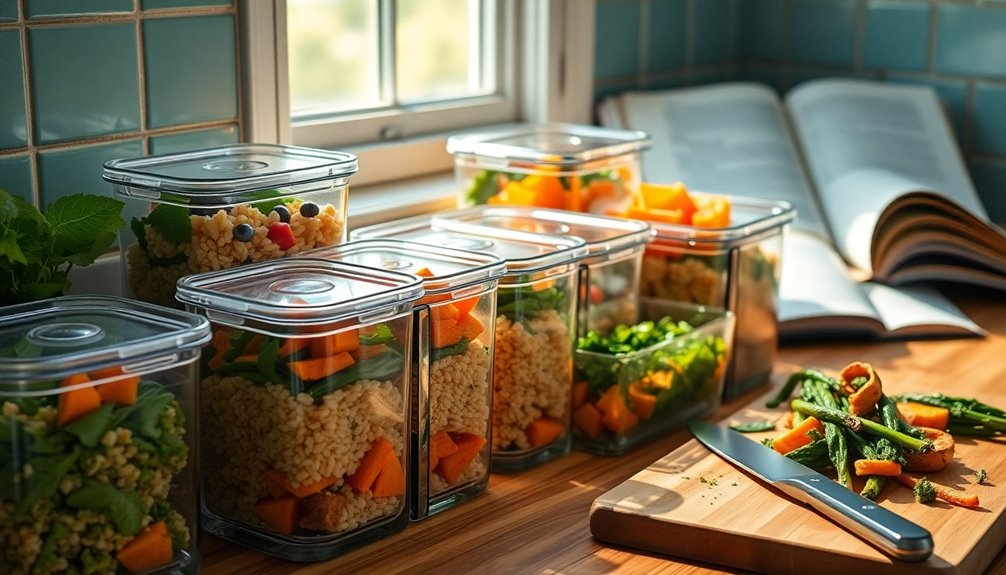
Cooking in batches is a smart strategy that can help you save time and effort while ensuring you have healthy meals ready when you need them. By preparing larger quantities of food, you're not just streamlining your cooking process but also enhancing your time management skills. Imagine dedicating a few hours once a week to create a variety of meals that satisfy your taste buds and nourish your body.
Start by picking a couple of recipes that you enjoy and can easily multiply. Think about incorporating different proteins, grains, and vegetables to create a diverse menu. This recipe variety keeps your meals exciting and prevents you from getting bored with your food choices.
You might whip up a big batch of grilled chicken, quinoa, and roasted vegetables one week, then switch to turkey chili or veggie stir-fry the next.
Additionally, cooking in batches allows for flexibility. If you have leftovers, you can freeze them for later use or mix and match components throughout the week. This way, you can enjoy a homemade meal even on your busiest days. Plus, having a custom keto diet plan can further optimize your meal prep by ensuring your meals align with your dietary goals.
Portion and Store Meals
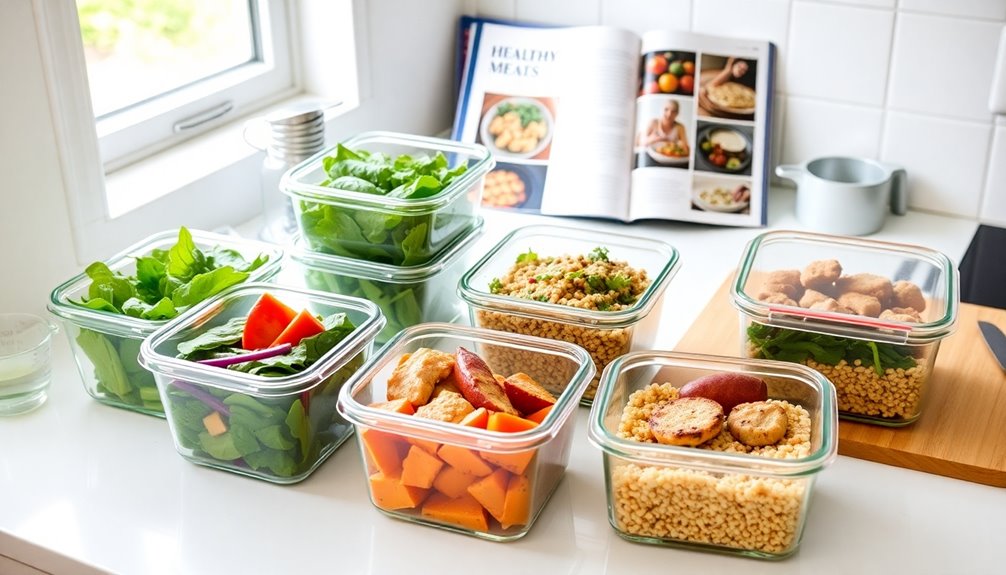
Properly portioning and storing meals is essential for maintaining the freshness and nutritional value of your food while also simplifying your weekly routine. When you take the time to divide your meals into appropriate meal sizes, you not only control your servings but also make it easier to grab and go during busy days.
Consider these effective storage options for your prepped meals:
- Glass containers: They're safe for reheating and won't stain or absorb odors.
- Plastic meal prep containers: Lightweight and often divided, these are perfect for portion control.
- Mason jars: Great for salads and overnight oats, they keep ingredients fresh and visually appealing.
- Freezer bags: Ideal for soups and stews, allowing you to lay them flat for easy stacking.
When deciding on meal sizes, aim to create balanced portions that contain a mix of proteins, carbohydrates, and healthy fats. This not only keeps your meals nutritious but also satisfying. Make sure to leave a little room for expansion if you're freezing meals, as liquids and grains can expand. Additionally, consider incorporating whole food sources of protein to maximize nutritional benefits in your meal prep.
Think about your week ahead—do you need meals for lunch, dinner, or both? Adjust your meal sizes accordingly and store them in the fridge or freezer based on when you plan to eat them. By organizing your meals this way, you'll save time, reduce food waste, and foster a sense of belonging to a healthier lifestyle.
Label and Date Containers
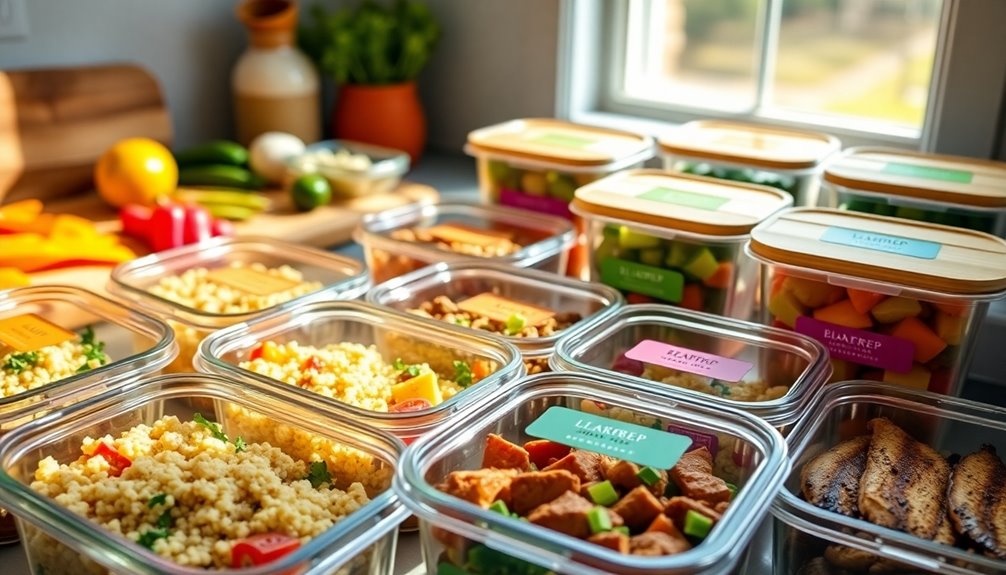
After you've portioned and stored your meals, labeling and dating your containers becomes an important next step. This practice not only enhances container organization but also guarantees you consume your meals while they're still fresh. By clearly marking your containers with meal prep labels, you'll avoid confusion about what's inside and when it needs to be eaten.
Start by using waterproof markers or label makers to write the name of the dish and the date it was prepared. This way, you can easily track expiration dates and minimize food waste.
If you're prepping multiple meals, consider color-coding your labels based on categories like proteins, grains, and vegetables. This simple system makes it easier to grab what you need, helping you stay on top of your meal plan.
When labeling, make sure the date is prominently displayed. A good rule of thumb is to consume meals within three to five days of preparation. For items that freeze well, you can extend their shelf life; just remember to note that on your labels. Incorporating plant-based recipes into your meal prep can significantly enhance your overall health and well-being.
Using these storage tips not only keeps your meals organized but also fosters a sense of belonging in your healthy eating journey. You're taking proactive steps toward maintaining a nutritious lifestyle, and that deserves recognition. By labeling and dating your containers, you create a more efficient and enjoyable meal prep experience, paving the way for healthier choices throughout the week.
Stay Flexible and Adapt
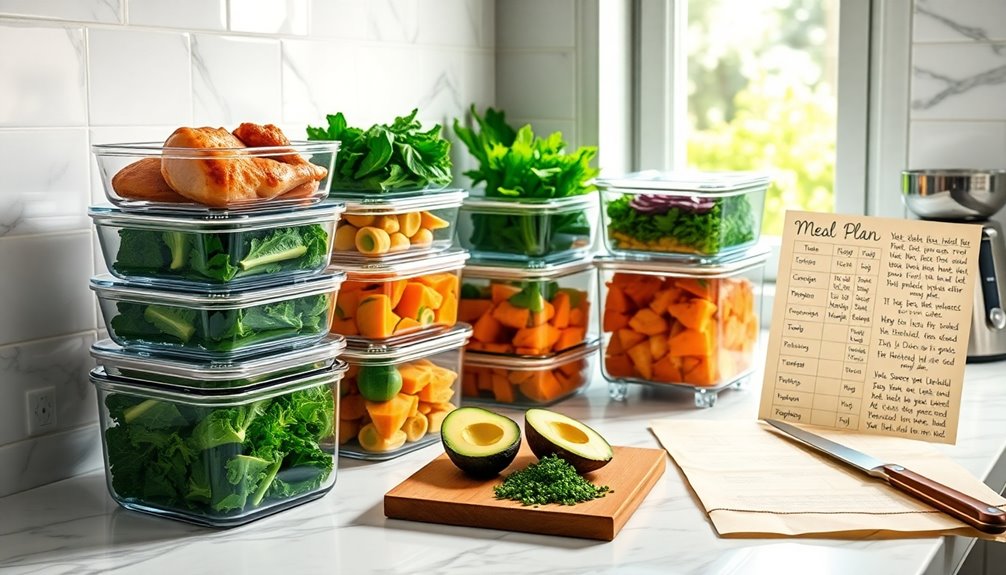
When you're progressing through your meal prep journey, staying flexible and adapting your plan can make all the difference. Life's unpredictability can throw your meal planning off course, but with a little creativity and an open mind, you can navigate these bumps with ease. Embracing flexibility means you won't get discouraged when things don't go as expected. Here are some practical tips to help you stay on track:
- Keep a variety of ingredients on hand: Stock your pantry and freezer with versatile staples. This allows for easy meal planning adjustments.
- Explore recipe substitutions: Don't hesitate to swap out ingredients based on availability or dietary preferences. For instance, if a recipe calls for quinoa but you have brown rice, use that instead.
- Plan for leftovers: Make extra portions of your meals. They can serve as quick lunches or dinners later in the week, giving you more time for other activities.
- Be open to new recipes: Sometimes, you might find yourself craving something different. Don't be afraid to experiment with new dishes that align with your health goals. Incorporating delicious Keto recipes can add variety and satisfaction to your meals while promoting better health.
Frequently Asked Questions
How Long Can Prepped Meals Be Stored in the Fridge?
When you prepare meals in advance, proper storage is key to maintaining their quality. Generally, prepped meals can be safely stored in the fridge for about three to four days. Beyond that, the shelf life decreases, and you risk foodborne illnesses. To maximize freshness, use airtight containers, label them with dates, and keep your fridge at the right temperature. This way, you can enjoy your meals without worry.
Can I Freeze All Types of Meals?
You might wonder if you can freeze all types of meals. The truth is, most meals freeze well, but some ingredients don't hold up. For instance, creamy sauces can separate, while leafy greens may wilt. Using proper freezing techniques, like airtight containers, helps maintain meal variety.
Cooked meats, grains, and stews generally freeze beautifully, allowing you to enjoy your favorites later without losing flavor or texture. So, go ahead and stock up confidently!
What Kitchen Tools Are Essential for Meal Prepping?
To effectively meal prep, you'll need some essential kitchen tools.
First, invest in good meal prep containers to store your food; glass or BPA-free plastic are great choices.
You can't forget utensils, either—having a reliable spatula and mixing spoons is vital.
A sturdy cutting board and sharp knives will make chopping and slicing a breeze.
With these tools, you'll streamline your cooking process and make meal prepping a more enjoyable experience.
How Do I Prevent Meal Boredom During the Week?
To prevent meal boredom during the week, focus on recipe variety and explore different flavor combinations. Try rotating proteins, grains, and vegetables in your meals. Consider using herbs and spices to add excitement. Incorporate themes like "Taco Tuesday" or "Stir-Fry Night" to keep things interesting.
You'll find that experimenting with new recipes not only satisfies your taste buds but also makes mealtime feel fresh and enjoyable, fostering a sense of belonging in your culinary journey.
Can I Meal Prep for Specific Dietary Restrictions?
Absolutely, you can meal prep for specific dietary restrictions! It's a common concern that prepping might limit your options, but it actually opens up a world of creativity.
You can focus on allergen-free options that cater to your needs, while also incorporating low carb alternatives to keep things interesting. By planning ahead, you guarantee that your meals aren't only safe but also delicious, making it easier to stick to your dietary goals.
Conclusion
By taking the time to meal prep, you're not just saving time; you're also making healthier choices. Did you know that meal prepping can lead to a 50% reduction in the chances of making unhealthy food decisions? With your balanced meals ready to go, you're more likely to stick to your nutrition goals. So, embrace the process, stay flexible, and enjoy the benefits of organized, nutritious eating throughout the week!

